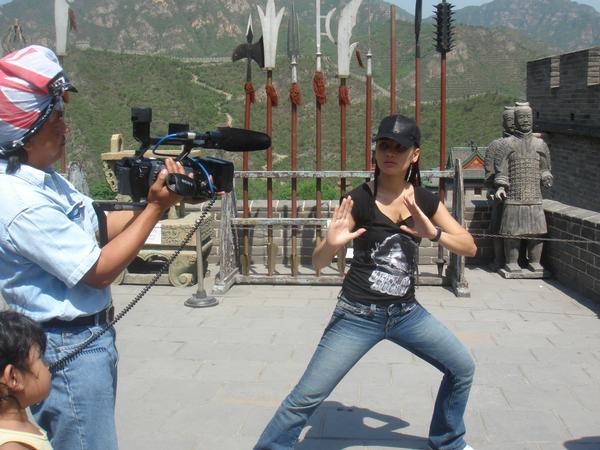

1 To 30 - Learn Tajweed with Yasir Qadhi - Introduction - The Noble Emissaries (As-Safara Al-Keram)
1 - Learn Tajweed with Yasir Qadhi - The Noble Emissaries (As-Safara Al-Keram)
A series about 'tajweed' and the art of reciting the Qur'an
Episode 1 -- Basic Introduction to the Series
Importance and Significance of Tajweed
The Prophet said, "Such a person as recites the Qur'an and masters it by heart, will be with the noble righteous scribes (in Heaven). And such a person exerts himself to learn the Qur'an by heart, and recites it with great difficulty, will have a double reward." (Sahih al-Bukhari, Vol.6 Bk.60 No.459)
2 - Learn Tajweed with Yasir Qadhi-The Noble Emissaries (As-Safara Al-Keram)
Episode 2 -- Etiquette of Reciting the Qur'an
Spiritual Etiquette
*Ikhlas (sincerity)
*Khushu' (humbleness)
*Expect the Reward
*Cleanse Heart of All Sins
Physical Etiquette
*Must Not Be in the State of Janabah When Reciting or Holding the Qur'an
*Must Be in the State of Wudhu when Touching Qur'an
*Must Not Disturb Others
*Must Say the Isti'adha (عوذ بالله من الشيطان الرجيم) Before Reciting Qur'an
*Encouraged to Say the Basmala (بسم الله الرحمن الرحيم) When Beginning to Recite, Especially at the Beginning of a Surah, Except Before Surah at-Taubah, Ch.9
*Recite in a Moderate Fashion, Not too Loud, Not too Quiet, Not too Fast, Not too Slow
3 - Learn Tajweed with Yasir Qadhi - The Noble Emissaries (As-Safara Al-Keram)
Episode 3 -- Makhaarij al-Jawf (Points of Articulation of the Oral Cavity) & Makhaarj al-Halq (Points of Articulation of the Throat)
Oral Cavity/Chest -- short vowel sounds: fat'ha (a), kasrah (i), dhamma (u),
Lower Throat -- ﺀ & ه
Middle Throat -- ع & ح
Upper Throat -- خ & غ
4 - Learn Tajweed with Yasir Qadhi - The Noble Emissaries (As-Safara Al-Keram)
Episode 4 -- Makhaarij al-Lisaan (Points of Articulation of the Tongue) I
Farthest Part of Tongue + Soft Palate -- ق
Back of the Tounge + Hard Palate -- ك
Middle of Tongue -- ي ش خ
One Side of Tongue + Molars -- ض
Front Edge of Tongue + Back of Teeth -- ل
Front Tip of Tongue + Back of Teeth -- ن
5 - Learn Tajweed with Yasir Qadhi - The Noble Emissaries (As-Safara Al-Keram)
Episode 5 -- Makhaarij al-Lisaan (Points of Articulation of the Tongue) II
Tip of Tongue + Gums of Incisor Teeth -- ر
Tip of Tongue + Upper Portion of Tongue + Gums -- ت ط د
Tip of Tongue + Gum, a Couple of Millimeters above Gum Line -- ز ص س
Upper Surface of Tongue + Tip of 2 Incisors + Tongue Extends Outside the Teeth -- ظ ذ ث
6 - Learn Tajweed with Yasir Qadhi - The Noble Emissaries (As-Safara Al-Keram)
Episode 6 -Makhaarij ash-Shafatayn (Points of Articulation of the Lips) and Makhraj al-Khayshum (Point of Articulation of the Nasal Cavity)
Both Lips -- م و ب
Lower Lip + Upper Teeth -- ف
Nose/Nasal Cavity -- Gunnah
7 - Learn Tajweed with Yasir Qadhi - The Noble Emissaries (As-Safara Al-Keram)
Episode 7 -- Isti'laa, Itbaaq, and Qalqalah
Isti'laa (tongue is raised to the roof of the mouth) -- ظ ق ط غ ض ص خ
Itbaaq (mouth is closed, puckered up from inside) -- ظ ط ض ص
Qalqalah (moving or shaking of sound, only happens on a silent letter, not a fat'ha) -- ق ط ب ج د
8 - Learn Tajweed with Yasir Qadhi - The Noble Emissaries (As-Safara Al-Keram)
Episode 8 -Tafkheem I
All letters of isti'laa are tafkheem.
ل -- Always tarqeeq (light), except in the proper name "Allah" when preceded by a fat'ha or dhamma (-allah/-ullah).
9 - Learn Tajweed with Yasir Qadhi - The Noble Emissaries (As-Safara Al-Keram)
Episode 9 -- Tafkheem II
ر -- Can be tafkheem or tarqeeq, based on the following rules.
* ر is tafhkeem when there is a fat'ha or dhamma on it, or when it is silent but preceded by a fat'ha or dhamma.
*ر is tarqeeq when there is a kasrah on it or when it is silent but preceded by a kasrah.
10-Learn Tajweed with Yasir Qadhi - The Noble Emissaries (As-Safara Al-Keram)
Episode 10 -- Tafkheem III
Exceptions to rules for ر mentioned in the previous episode.
* ر is always tafkheem whenever it is preceeded directly by a أ (hamzat ul-wasl).
* A silent ر, when preceded by a silent ي, will always by tarqeeq.
*ر is always tafkheem when preceded by a letter of isti'laa.
* When ر is silent, is preceded by a silent letter, and the third letter before it has a fat'ha or dhamma, that ر is considered tafkheem.
* When ر is silent, is preceded by a silent letter, and the third letter before it has a kasrah, that ر is considered tarqeeq.
11- Learn Tajweed with Yasir Qadhi - The Noble Emissaries (As-Safara Al-Keram)
Episode 11 -Rumuz al-Awqaf (Stop Signs)
مـ -- must stop
قلي -- better to stop
ج -- allowed to stop
صلي -- better not to stop
لا -- should not stop
12-Learn Tajweed with Yasir Qadhi - The Noble Emissaries (As-Safara Al-Keram)
Episode 12 -Huruf Shamsiyya (Solar Letters) & Huruf Qamariyya (Lunar Letters)
Huruf Shamsiyya (letters which, when are at the beginning of a noun, assimilate the ل of a preceding article) -- ﻥ ﻝ ﻅ ﻁ ﺽ ﺹ ﺵ ﺱ ﺯ ﺭ ﺫ ﺩ ﺙ ﺕ
Huruf Qamariyya (letters which, when are at the beginning of a noun, do not assimilate the ل of a preceding article, meaning the ل is pronounced) -- ه ﻱ ﻭ ﻡ ﻙ ﻕ ﻑ ﻍ ﻉ ﺥ ﺡ ﺝ ﺏ
13 - Learn Tajweed with Yasir Qadhi - The Noble Emissaries (As-Safara Al-Keram)
Episode 13 -- Idh-haar (Clarity)
Any ghunnah is held for two harakas.
Letters of Idh-haar (when a nun sakinah or tanween is followed by one of these letters, simply pronounce the nun sakinah or tanween crips and clear) -- any letter from makhaarij al-halq
14 - Learn Tajweed with Yasir Qadhi - The Noble Emissaries (As-Safara Al-Keram)
Episode 14 -- Iqlaab (Conversion) & Idghaam (Merging) I
Iqlaab (changing the nun sakinah or tanween into a م instead, sometimes signified in a mus'haf by a م) -- only when followed by a ب
Idghaam without Ghunnah (the nun sakinah or tanween is bypassed so that the letter before it is connected to the letter after it, and no ghunnah is pronounced) -- ر ل
15 - Learn Tajweed with Yasir Qadhi - The Noble Emissaries (As-Safara Al-Keram)
Episode 15 -- Idghaam (Merging) II
Idghaam with Gunnah (the nun sakinah or tanween is bypassed so that the letter before it is connected to the letter after it, but there is a ghunnah pronounced within that connection) -- و م ن ي
16 - Learn Tajweed with Yasir Qadhi - The Noble Emissaries (As-Safara Al-Keram)
Episode 16 -- Ikhfaa (Supressing)
Ikhfaa (supressing or hiding the sound of the nun sakinah or tanween with a ghunnah) -- all remaining letters that have not been addressed by idhaar, iqlaab, or idgham
17 - Learn Tajweed with Yasir Qadhi - The Noble Emissaries (As-Safara Al-Keram)
Episode 17 -- The Silent م
Idghaam Shafawai (Idghaam of the Lips) -- when followed by another م, with ghunnah, usually indicated with a shaddah
Ikhfaa Shafawai -- when followed be a ب, with ghunnah
Idhaar Shafawi -- remaining 26 letters, no special rule
18 - Learn Tajweed with Yasir Qadhi - The Noble Emissaries (As-Safara Al-Keram)
Episode 18 -Rules of Madd (Elongation) I
Letters of Madd -- وي ا, preceded by fat'ha, kasra, or dhamma, in that order, respectively
Natural Madd -- occurs when a letter of madd is neither preceded nor followed by hamza or sukoon; 2 harakas
Madd al-`Iwadh (Replacement Madd) -- when stopping on a double fat'ha, it becomes a natural mad
Madd al-Badal (Substitution Madd) -- hamza occurs before madd; 2 harakas
19 - Learn Tajweed with Yasir Qadhi - The Noble Emissaries (As-Safara Al-Keram)
Episode 19 -Rules of Madd II
Hamza After Madd
Al-Madd Al-Muttasil (Connected Madd) -- within the same word, so lengthen to 4or 5 harakas
AL-Madd Al-Munfassil (Seperated Madd) -- different words, so lengthen to 2, 4, or 5 harakas
20 - Learn Tajweed with Yasir Qadhi - The Noble Emissaries (As-Safara Al-Keram)
Episode 20 -- Rules of Madd III
Sukoon after Madd
Aridh li Sukoon (Voluntary Stop, no written sukoon, as if you ran out of breath or reached the end of a verse) -- 2, 4, or 5 harakas
Madd al-Leen (Easygoing Madd, silent ي or و, preceded by a fat'ha) -- 2, 4, or 5 harakas
21 - Learn Tajweed with Yasir Qadhi - The Noble Emissaries (As-Safara Al-Keram)
Episode 21 -- Rules of Madd IV
Real Sukoon After Madd
Madd Lazim Kalimi (mandatory, one word; real, permanent sukoon after madd) -- 6 harakas
*proper sukoon -- only one word in the entire Qur'an, occurs twice in Surah Yunus, Ch. 10 vv.51, 91: أَالآنَ
*shaddah -- indicates that there are two of that letter, the first with a sukoon, followed by the same letter with a haraka
22 - Learn Tajweed with Yasir Qadhi - The Noble Emissaries (As-Safara Al-Keram)
Episode 22 -- Rules of Madd V
Madd as-Sillah (Connecting Madd) -- refers to masculine pronoun of third person (for example, his book, كتابه), sounds similar to the و vowel sound
*If either letter before or after it is silent, no madd
*If letter before is not silent, and after it is hamza, then 2, 4, or 5 harakas
*If letter before is not silent, and after it is any letter besides hamza, only 2 harakas
23 - Learn Tajweed with Yasir Qadhi - The Noble Emissaries (As-Safara Al-Keram)
Episode 23 -- Rules of Madd VI
Madd al-Lazim al-Harfi (al-Muqata'aat, the Abbreviated Letters)
*only pronounce name, no madd: ا
*madd of 2 harakas: ح ي ط ه ر
*madd of 6 harakas: ن ق ص ع س ل ك م
24 - Learn Tajweed with Yasir Qadhi - The Noble Emissaries (As-Safara Al-Keram)
Episode 24 -- Special Types of Idghaam I
*Any time a silent letter is followed by the same letter, idghaam occurs. If that letter happens to be a ن or م, a ghunnah occurs as well.
* 2 Letters with Close Makhaarij: ر ل, ل gets dropped; ق ك, first letter gets dropped
25 - Learn Tajweed with Yasir Qadhi - The Noble Emissaries (As-Safara Al-Keram)
Episode 25 -- Special Types of Idghaam
Letters of Similar Characteristics
ذ followed by ظ; drop the ذ
تfollowed by د; drop the ذ
ت followed by ط; drop the ذ
د followed by ت; drop the د
ب followed by م; drop the ب
ث followed by ذ; drop the ث
ط followed by ت; drop the ت
26 - Learn Tajweed with Yasir Qadhi - The Noble Emissaries (As-Safara Al-Keram)
Episode 26 -- Exceptions I
Saktah (to pause momentarily without breathing, 4 places in Qur'an, may be shown by a small س)
*Surah Kahf, Ch. 18 v.1 -- عِوَجَا
*Surah Ya-Sin, Ch.36 v.52 -- مَرْقَدِنَا
*Surah al-Qiyamah, Ch.75 v.27 -- مَنْ
*Surah al-Mutaffifin, Ch.83 v.14 -- بَلْ
Madd as-Sillah Exceptions
* Surah Zumar, Ch.39 v.7, no madd -- يَرْضَهُ
*Surah Furqan, Ch.25 v.69, with madd on the فِيهِ -- ه
Ishmaam (show with lips a dhammah being pronounced, but no dhamma is pronounced)
*Surah Yusuf, Ch. 12 v.11 -- تَأْمَنَّا, on the ن
27 - Learn Tajweed with Yasir Qadhi - The Noble Emissaries (As-Safara Al-Keram)
Episode 27 -- Exceptions II
Imaalah (to produce sounds between ا and ي, sometimes symbolized by a diamond
*Surah Hud, Ch.11 v. 41 -- مَجْرَاهَا, pronounced "najrayha," not "majraha" nor "majriha"
Tas'heel of Hamza (pronounce hamza between alif and hamza)
Surah Fussilat, Ch.41 v.44 -- أَأَعْجَمِيٌّ
س vs ص -- sometimes these two are exchanged in recitation even if not reflected in the spelling
Sural al-Baqarah, Ch.2 v.245 -- وَيَبْسُطُ, must use س
Surah al-A'raf, Ch.7 v.69 -- بَسْطَةً, must use س
Surah at-Tur, Ch.52 v.37 -- الْمُسَيْطِرُونَ -- preferred to use ص
Surah al-Ghashiyah, Ch.88 v.22 -- بِمُسَيْطِرٍ -- preferred to use ص
28 - Learn Tajweed with Yasir Qadhi - The Noble Emissaries (As-Safara Al-Keram)
Episode 28 -- Demonstration of Proper Recitation by a Guest Qari I
Surah Ya-Sin, Ch.36 vv.1-11
29 - Learn Tajweed with Yasir Qadhi - The Noble Emissaries (As-Safara Al-Keram)
Episode 29 -- Demonstration of Proper Recitation by a Guest Qari II
Surah Ya-Sin, Ch.36 vv.71-83
30 - Learn Tajweed with Yasir Qadhi - The Noble Emissaries (As-Safara Al-Keram)
Episode 30 -- Practical Steps for Memorizing the Qur'an
Spiritual Pre-Conditions
*sincerity
*humility
*du'a
*leave sins
*live life by Qur'an
Physical Pre-Conditions
*memorize earlier in the day
*pick one mus'haf
*consistency
*quiet place
*understand
*recite in prayer



























































































No comments:
Post a Comment